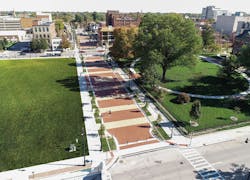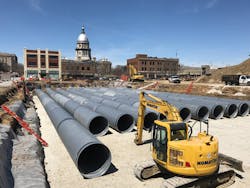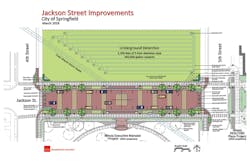Above and Below
Streetscape Project Results in Value-Added Stormwater Improvements
By Christopher J. Stritzel
Springfield, Ill., is well-known for being the hometown of Abraham Lincoln. The house where he raised his family, the office where he practiced law and the capitol where he embarked on his political career are all located within blocks of each other and draw hundreds of thousands of visitors each year. But like many historic downtown areas throughout the country, Springfield has stormwater and combined sewer overflow issues resulting from old and inefficient sewer infrastructure.
City leaders have long sought relief for Springfield’s overtaxed sewer system. But it wasn’t until a recent streetscape initiative, undertaken in conjunction with the state of Illinois’ Bicentennial Celebration in 2018, that an opportunity presented itself for implementing an innovative and affordable solution that would have a significant impact on area stormwater management.
Springfield’s downtown is part of an 1,800-acre watershed served by an 84-inch, brick arch combined sewer (commonly referred to as the Town Branch), the largest combined sewer system in the city. The sewer was constructed in the 1860s, just years after Lincoln left for the White House in Washington, D.C. Today, the outdated and under-sized sewer system surcharges during heavy rain events, leading to street closures and other inconveniences to businesses as well as motorists and pedestrians.
Crawford, Murphy & Tilly (CMT) — a 16-office engineering consulting firm that was founded in Springfield, Ill., in 1946 — was familiar with the downtown sewer system, having led the CSO Long Term Control Planning for the city, along with subsequent hydraulic modeling for the downtown area. Given the unique location of the Jackson Street revitalization project, CMT realized an opportunity to integrate its construction and funding with an opportunity to make major progress on the city’s downtown stormwater issues.
A block of Jackson Street was chosen for the streetscape revitalization due to its proximity to the state’s Governor’s Mansion. But even more intriguing to CMT’s stormwater experts was that the Town Branch sewer runs diagonally directly under the street, and on the other side of the street sat a recently-vacated block of city-owned property.
The North Mansion block, which had once been a thriving location for business and entertainment, had been abandoned for more than a decade. The city had recently purchased the property and demolished the last standing vacant structure. While the city was evaluating proposals for redevelopment of the block, it also presented an exceptional opportunity to consider the space below for a highly practical use — a large underground stormwater detention facility.
Could the area beneath the existing vacant block be used to relieve pressure from the overtaxed Town Branch combined sewer system? Could a design be provided that wouldn’t impede future development on the surface? And would all of this even be worth it, since the ultimate goal was to mitigate 100+ years of unrestricted development?
The Jackson Street Corridor project provides streetscape revitalization and stormwater improvements to create a pedestrian-friendly corridor that will enhance the visitor experience for tourists visiting Springfield’s historical sites and provide more opportunities for outdoor events in the downtown area.
The city began answering these questions by having CMT update the existing EPA stormwater management model (SWMM) to measure the impact of various detention options. It allowed for the assessment of the incremental benefit the various alternatives would provide to the surcharging of the Town Branch sewer during various storm events at multiple locations within the watershed. Improvements to the system were evaluated to determine the feasibility of implementing system changes that either would reduce the volume of runoff or delay the runoff entering the sewer system.
Alternatives of differing shapes and sizes were studied, including underground detention beneath the block itself, underground detention beneath the streetscape improvements, and potential strategic future above- and below-grade storage areas both upstream and downstream of the project site. Results of the model quickly began to validate the incremental benefit of providing in-line detention storage adjacent to the Town Branch and the benefit to known problem areas both immediately upstream and downstream of the proposed project. The model also confirmed that stormwater would effectively flow both into and out of the detention system through an orifice connection.
In addition to the variables to consider regarding location and size, it became clear during design that having to accommodate combined sewage limited the system types available to the team for use on this project. The team focused on designing a network of oversized pipes with prefabricated fittings and considered materials such as RCP, PVC, SRPE, fiberglass, HDPE and PP. Providing the city with more than one viable option for system materials allowed for a competitive bidding environment. In the end, both ADS’s SaniTite pipe and Contech’s steel reinforced polyethene pipe (SRPE) proved to be the most cost-effective solutions as alternatives for the system.
The underground detention facility is comprised of a 2,300-foot network of five-foot diameter pipes constructed in an 11-foot-deep excavation, and designed to hold 340,000 gallons of stormwater at maximum capacity. The entire system was wrapped with a geosynthetic clay liner to protect the pipes from contaminated soils and groundwater, a unique application for a detention facility.
Meeting the city’s constraints for use of the space, which included utilizing up to one-third of the vacant block, the underground stormwater storage system is the first of its kind for a City of Springfield-owned project. The 340,000-gallon (45,600 cubic feet) capacity system from Advanced Drainage Systems is connected to the Town Branch sewer and is expected to be a significant first step in addressing surcharging and flooding conditions in the downtown area during smaller-intensity rain events by reducing pressure on the undersized sewer system. But before that could happen, a significant obstacle had to be overcome.
The project site is located in an area that has seen a variety of developments over the past 150 years, including a wool factory, rubber company, auto service center and photo studio. These past uses resulted in contamination of both the soil and groundwater within the project limits, presenting a severe design constraint with respect to the proposed detention system. Designers were concerned that the contaminated soil and groundwater would, over time, compromise the structural integrity of the plastic pipe system and/or rubber gasketed joints.
Since removing the contaminants would be cost prohibitive, and neither pipe manufacturer would guarantee their pipe would withstand the effects of the diluted contaminants, it was determined that wrapping the entire excavation with a geosynthetic clay liner would protect it from exposure to contaminated groundwater or soil migration. This solution was selected after collaboration with the local sanitary district (Sangamon County Water Reclamation District), which will have responsibility for maintaining the system. The liner, supplied by CETGO, is most commonly found in mines and landfills; its application in a utility trench setting is both unique and critical — and ultimately provided the necessary assurance for this project to move forward.
The surface of the streetscape project itself was designed with stormwater in mind utilizing permeable pavers (from Belden Brick Company) to help reduce runoff. In addition to their practical function, the pavers added to the aesthetics of the project along with the various pedestrian-friendly improvements to walks and crossings and upgraded corridor lighting and landscaping.
The Jackson Street Corridor project provides streetscape revitalization and stormwater improvements through a one-block section in Springfield, Ill. The project features the first city-owned underground stormwater detention facility.
To help fund the improvements, the city sought council approval for the use of tax increment financing (TIF) funds earmarked for the downtown area. While city leaders were certain that the streetscape features would provide value, it was determined that addressing the flooding problems, an issue that resonated loudly with citizens and businesses in the area, would increase the likelihood that the council would be on board and allocate the needed money. CMT worked with the city to present the case to the council, which responded with $830,000 in TIF funding for the $2.7 million project.
The project was coordinated with two additional downtown enhancement projects immediately adjacent to this site and completed on a fast-track schedule so that the corridor could be host to an Illinois Bicentennial Celebration on August 26, 2017. With this tight construction timeframe, the contractor was given the green light to proceed with construction in early March 2017.
Despite heavy rains slowing the project at the onset, the contractor was able to successfully complete construction of the sewer and streetscape by the end of June 2017 — ahead of schedule and in plenty of time for the celebration.
To date, the city has been able to confirm that the system has activated on multiple occasions. Moving forward, plans are in place to install flow monitors so that system data can be collected and correlated with data from the adjacent Town Branch sewer system. WW
About the Author: Christopher J Stritzel, P.E., is a project engineer with Crawford, Murphy & Tilly. He can be reached at [email protected].
Circle No. 246 on Reader Service Card



